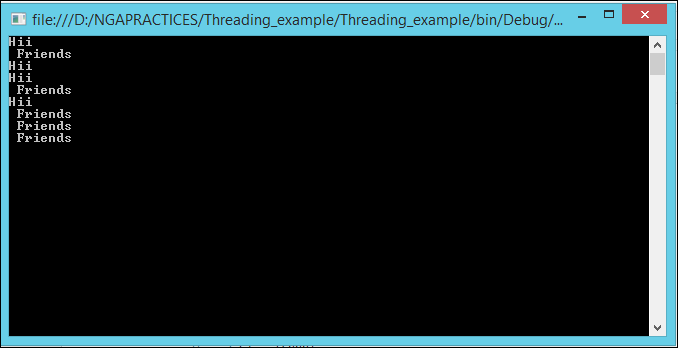Multithreading is used to perform multiple tasks at the same time. Tasks with the potential of holding up other tasks can execute on separate threads, a process known as multithreading. Or, it's basically trying to do more than one thing at a time within a process.
OUTPUT
thread.Priority = ThreadPriority.Lowest
Namespace
In .NET, threading functionality is defined in the System.Threading namespace. So you have to define System.Threading namespace before using any thread classes.
using System.Threading;
Starting a Thread
A C# client program starts in a single thread created automatically by the CLR and operating system that is called the main thread, and is made multithreaded by creating additional threads. Here's a simple example and its output.
using System;
using System.Collections.Generic;
using System.Linq;
using System.Text;
using System.Threading;
namespace Threading_example
{
class Program
{
static void Main(string[] args)
{
Thread t1 = new Thread(Function2);
t1.Start();
for (int
i=0;i<4;i++)
{
Console.WriteLine("Hii");
// Console.ReadLine();
}
Console.ReadLine();
}
private static void
Function2()
{
for (int
i=0;i<5;i++)
{
Console.WriteLine(" Friends");
//Console.ReadLine();
}
}
}
}
OUTPUT
In the above example, the main thread creates a new thread on which it runs a method that repeatedly prints the string "Friends".Simultaneously, the main thread repeatedly prints the string
"Hii".
Abort a Thread
The Thread class's Abort method is called to abort a thread. Make sure you check the IsAliveproperty before Abort.
if (t1.IsAlive)
{
t1.Abort();
}
---------------------------------------------------------------
using System;
using System.Collections.Generic;
using System.Linq;
using System.Text;
using System.Threading;
namespace Threading_example
{
class Program
{
static void Main(string[] args)
{
Thread t1 = new Thread(Function2);
if (t1.IsAlive)
{
t1.Abort();
}
for (int
i=0;i<4;i++)
{
Console.WriteLine("Hii");
// Console.ReadLine();
}
Console.ReadLine();
}
private static void
Function2()
{
for (int
i=0;i<5;i++)
{
Console.WriteLine(" Friends");
//Console.ReadLine();
}
}
}
}
In the above example, The main thread creates a new thread which is stopped by the abort method. The main thread repeatedly prints the string "Hii".
Pausing a Thread
The Thread.Sleep method can be used to pause a thread for a fixed period of time.
Thread.Sleep()
---------------------------
using System;
using System.Collections.Generic;
using System.Linq;
using System.Text;
using System.Threading;
namespace Threading_example
{
class Program
{
static void Main(string[] args)
{
Thread t1 = new Thread(Function2);
t1.Start();
for (int
i=0;i<4;i++)
{
Console.WriteLine("Hii");
Thread.Sleep(2000);
}
Console.ReadLine();
}
private static void
Function2()
{
for (int
i=0;i<5;i++)
{
Console.WriteLine(" Friends");
Thread.Sleep(6000);
}
}
}
}
OUTPUT
In the above example, the main thread creates a new thread which is paused by the Sleep method for 6000 milliseconds. The main thread is also paused by a Sleep method for 2000 milliseconds.
Thread Priority
The Thread class's ThreadPriority property is used to set the thread's priority. The thread priority can have Normal, AboveNormal, BelowNormal, Highest, and Lowest values.
-------------------------------------------------------
using System;
using System.Collections.Generic;
using System.Linq;
using System.Text;
using System.Threading;
namespace Threading_example
{
class Program
{
static void Main(string[] args)
{
Thread t1 = new Thread(Function2);
t1.Priority = ThreadPriority.Lowest;
t1.Start();
for (int
i=0;i<4;i++)
{
Console.WriteLine("Hii");
}
Console.ReadLine();
}
private static void
Function2()
{
for (int
i=0;i<5;i++)
{
Console.WriteLine(" Friends");
}
}
}
}
-----------------------------------------
Suspend a Thread
The Suspend method of the Thread class suspends a thread. The thread is suspended until the Resume method is called.
if (t1.ThreadState == ThreadState.Running)
{
{
t1.Suspend();
}
Resume a suspended Thread
The Resume method is called to resume a suspended thread. If the thread is not suspended, the Resume method will have no effect.
if (t1.ThreadState == ThreadState.Suspended) {
t1.Resume();
}
--------------------------------------------------------------------
using System;
using System.Collections.Generic;
using System.Linq;
using System.Text;
using System.Threading;
namespace Threading_example
{
class Program
{
static void Main(string[] args)
{
Thread t1 = new Thread(Function2);
// t1.Priority = ThreadPriority.Lowest;
//t1.Resume();
//t1.Suspend();
t1.Start();
for (int
i=0;i<4;i++)
{
Console.WriteLine("Hii");
Thread.Sleep(100);
}
Console.ReadLine();
}
private static void
Function2()
{
for (int
i=0;i<5;i++)
{
Console.WriteLine(" Friends");
Thread.Sleep(50);
}
}
}
}



No comments:
Post a Comment